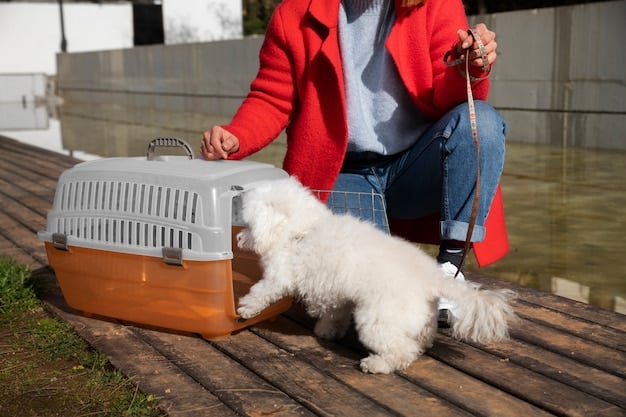Crate Training in 14 Days: The Ultimate Guide

Anúncios
The Ultimate Guide to Crate Training offers a step-by-step approach to successfully crate train your dog in 14 days or less, covering everything from introducing the crate to addressing common challenges for a well-adjusted, happy pet.
Unlock the secrets to successful crate training with our comprehensive guide! Learn how to crate train your dog in 14 days or less, creating a safe and comfortable space they’ll love. This is The Ultimate Guide to Crate Training: Achieve Success in 14 Days or Less.
Anúncios
Understanding Crate Training: Why It Matters
Crate training is more than just confining your dog; it’s about providing a secure and comfortable den. Used correctly, it can be an invaluable tool for house training, preventing destructive behaviors, and providing a safe haven for your furry friend.
Establishing a positive association with the crate is key. This helps ensure your dog sees the crate as a safe and relaxing retreat, not a punishment.
Anúncios
Benefits of Crate Training
Crate training offers numerous advantages for both you and your dog. It’s a valuable asset in various aspects of pet ownership.
- House Training Aid: Dogs naturally avoid soiling their sleeping area, making a crate an effective aid in house training.
- Security and Comfort: The crate can become a safe haven for your dog, a place they can retreat to when feeling anxious, stressed, or simply in need of rest.
- Travel Companion: A crate-trained dog travels much easier, as they are already accustomed to being confined in a secure space.
- Prevents Destructive Behavior: When you can’t supervise your dog, crating them prevents them from engaging in destructive behaviors like chewing furniture or digging.
Crate training can greatly improve your dog’s well-being while also providing you as an owner peace of mind.

Choosing the Right Crate: Size and Type
Selecting the appropriate crate is essential for your dog’s comfort and safety. The crate should be just big enough for your dog to stand up, turn around, and lie down comfortably. A crate that is too large might encourage your dog to eliminate in one corner and sleep in the other, defeating the purpose of house training.
There are various crate types available, each with its own advantages and disadvantages. Consider your dog’s personality, size, and your specific needs when making your selection.
Types of Crates
Different situations might call for different types of crates. Here’s a quick overview of the most common types:
- Wire Crates: These are popular because they provide good ventilation and visibility. They are often foldable for easy storage and transport.
- Plastic Crates: These are often used for travel, as they are durable and easy to clean. They provide more privacy for your dog, which can be comforting for some.
- Soft-Sided Crates: These are lightweight and portable, making them ideal for travel or temporary use. However, they are not suitable for dogs who are prone to chewing.
Choosing the right crate type will greatly impact your dog’s comfort and the success of crate training.
The 14-Day Crate Training Schedule: Step-by-Step
A structured approach is crucial for successful crate training. This 14-day schedule is designed to gradually introduce your dog to the crate, building positive associations along the way. Remember to be patient and adjust the schedule as needed based on your dog’s individual progress.
Consistency is key. Stick to the schedule as closely as possible, and always end each training session on a positive note.
Days 1-3: Introduction to the Crate
Focus on making the crate a positive and inviting space for your dog with these first steps:
- Day 1: Place the crate in a high-traffic area of your home. Leave the door open and encourage your dog to explore it by tossing treats or toys inside.
- Day 2: Feed your dog their meals inside the crate. If they are hesitant, place the food bowl just inside the door, gradually moving it further inside as they become more comfortable.
- Day 3: Start closing the crate door for short periods while your dog is eating. Gradually increase the duration, always rewarding them with praise and treats.
Dealing with Common Crate Training Challenges
Crate training isn’t always smooth sailing. You will encounter challenges along the way, some of which could be frustrating, but with patience and consistency, you can overcome these hurdles and achieve crate training success.
Addressing these difficulties proactively will minimize frustration and keep your dog on track.

Separation Anxiety
Some dogs develop anxiety when left alone in their crate, displaying behaviors like excessive barking, whining, or destructive chewing.
You can address separation anxiety by gradually increasing the time your dog spends in the crate, starting with just a few minutes and working up to longer periods. Make sure your dog has plenty of exercise and mental stimulation before crating them, and provide them with a favorite toy or chew item.
Whining and Barking
It’s natural for dogs to express their discontent with whining. Here’s how to address the behavior:
- Ignore the Noise: If your dog is whining or barking for attention, avoid responding. This reinforces that making noise gets them what they want.
- Reward Quiet Behavior: Praise and reward your dog when they are quiet and relaxed in the crate.
- Ensure Comfort: Make sure your dog isn’t whining because they are uncomfortable, too hot, too cold, need to go to the bathroom. Eliminate these possibilities first.
Maintaining a Positive Crate Association Long-Term
Crate training is not a one-time event; it’s an ongoing process. To maintain a positive crate association, continue to use the crate regularly, even after your dog is fully trained. This will help reinforce the crate as a safe and comfortable space.
Avoid using the crate as a punishment. This can create negative associations and undo all of your hard work. Instead, continue to use it as a place of comfort and security.
Tips for Long-Term Success
Crate training is a continued activity; here are tips to consider for long-term success:
- Regular Use: Use the crate for naps and overnight sleeping, but don’t force your dog inside.
- Positive Reinforcement: Use treats, praising, and toys to reward your dog’s calm behavior in the crate.
- Avoid Overuse: Limit the amount of time your dog spends in the crate each day to prevent them from feeling confined or isolated.
Advanced Crate Training Techniques: Beyond the Basics
Once your dog is comfortable in their crate, you can explore advanced training techniques to further enhance their crate skills. This includes teaching them to enter the crate on command, stay in the crate for extended periods, and remain calm and relaxed even when you are not present.
These advanced techniques can be particularly useful for dogs who need to be crated for longer periods, such as during travel or when you are at work.
Day 4-7: Building Positive Associations
Enhance the crate’s appeal and make sure your dog enjoys being there:
- Offer Treats: Lure your dog into the crate with a treat and praise them once they are inside.
- Practice Short Stays: Gradually increase the amount of time they spend inside while you are in the room.
- Make it Cozy: Add comfortable bedding and toys to make it more inviting.
| Key Point | Brief Description |
|---|---|
| 🏠 Crate Introduction | Make the crate a positive and inviting space. |
| ⏰ Gradual Increase | Slowly increase crate time to build comfort. |
| ✅ Consistency | Consistent training reinforces positive crate associations. |
| 🎉 Reward System | Reward calm crate behavior with treats and praise. |
Frequently Asked Questions (FAQ)
▼
Adult dogs shouldn’t be crated more than 6-8 hours. Puppies need more frequent breaks, so limit their crate time to 2-4 hours. Balance crate time with exercise and interaction.
▼
Ignore attention-seeking behaviors like crying or barking, rewarding them when they quiet down. If the crying persists, make sure your dog isn’t uncomfortable and needs to go potty.
▼
Never use the crate as punishment. This will create negative associations with the crate, and your dog will see it as a place of fear and resentment rather than a safe and happy place.
▼
Add soft bedding like blankets or a dog bed to make the crate cozier. You can also include safe toys or chew items to entertain your dog while they are inside. Ensure that the crate is also a comfortable temperature.
▼
Crate training can be ongoing. Some dogs continue to use their crate as a den. If your dog is fully house-trained, and doesn’t display any destructive behaviors, you can gradually let them free.
Conclusion
Crate training is a beneficial tool that when applied correctly can create a safe space for your dog, helps with house training, and prevent them from being destructive. By following this guide, maintaining patients, and staying consistent, you will be well on your way to having a well trained happy dog.






